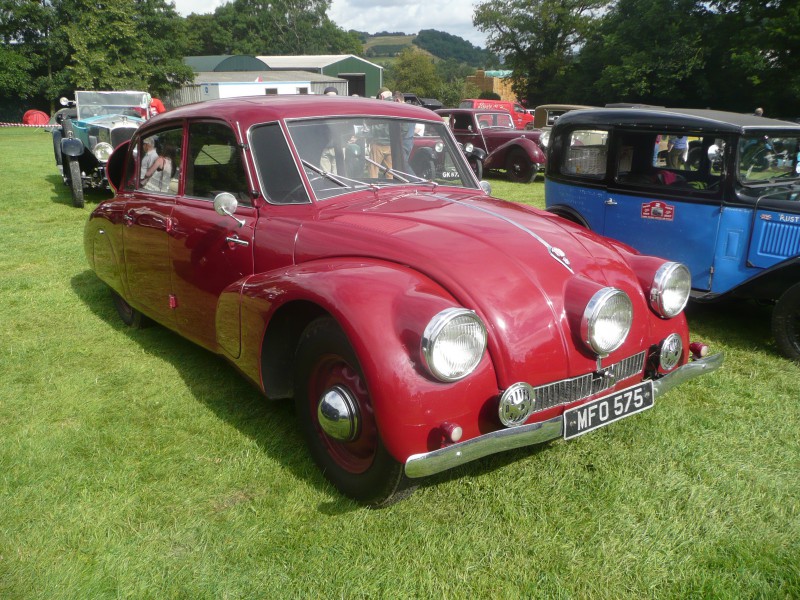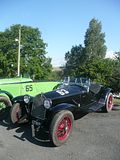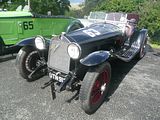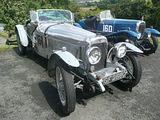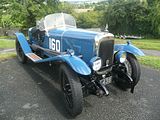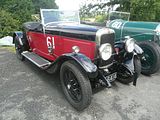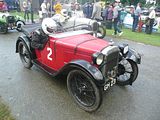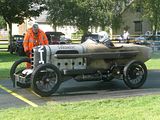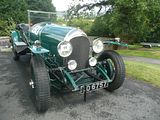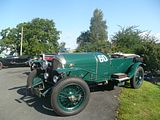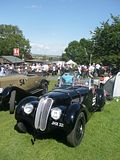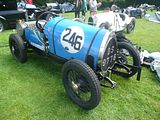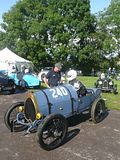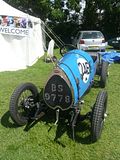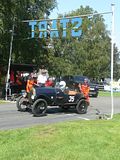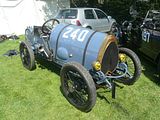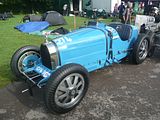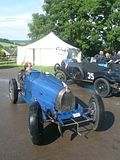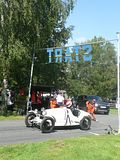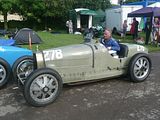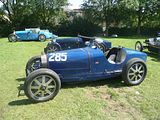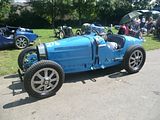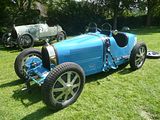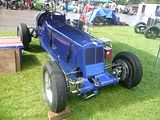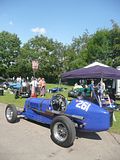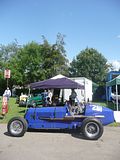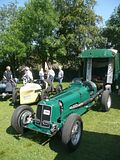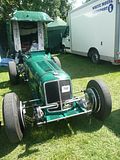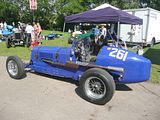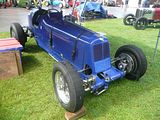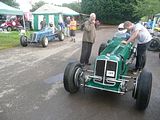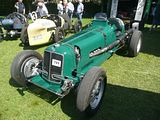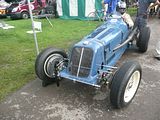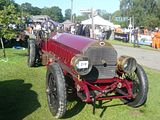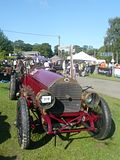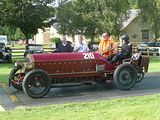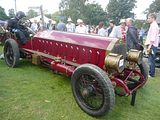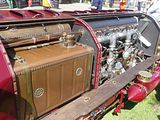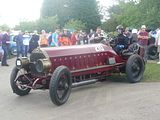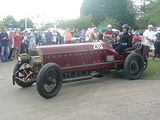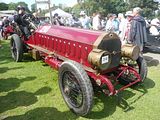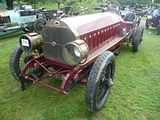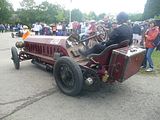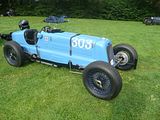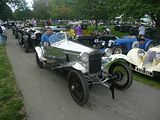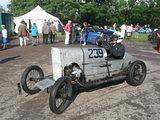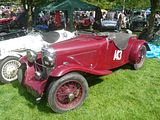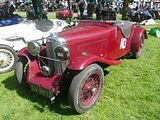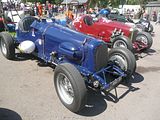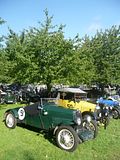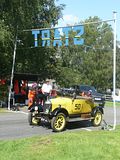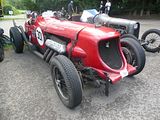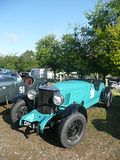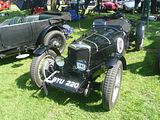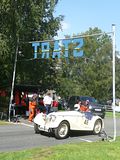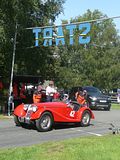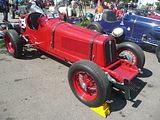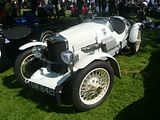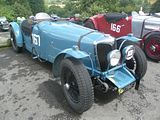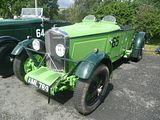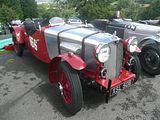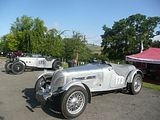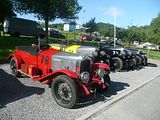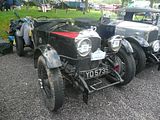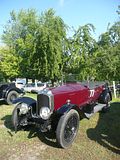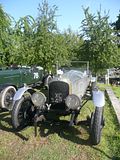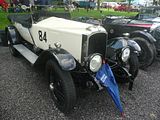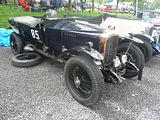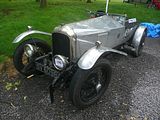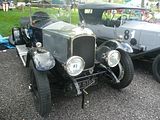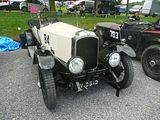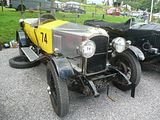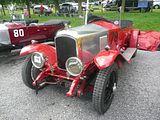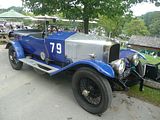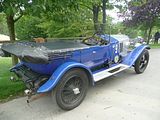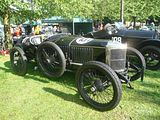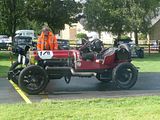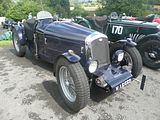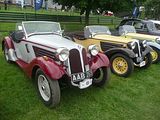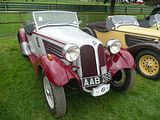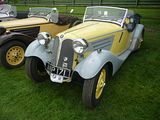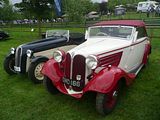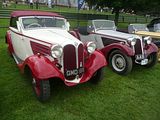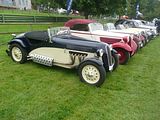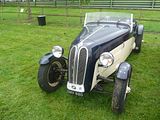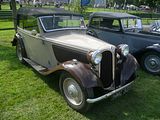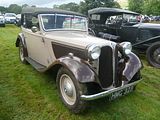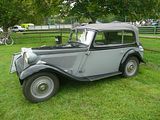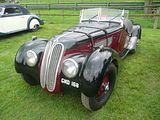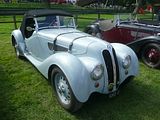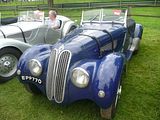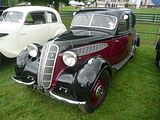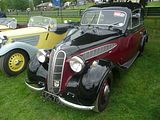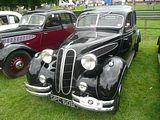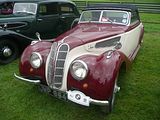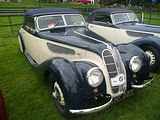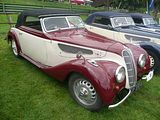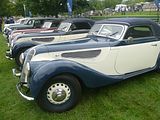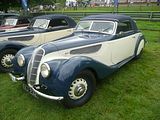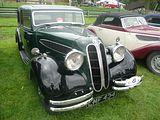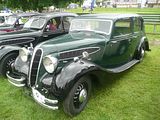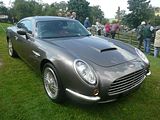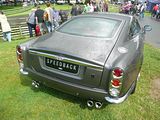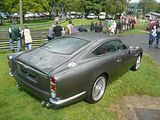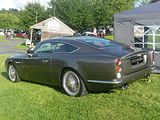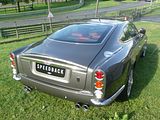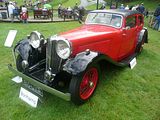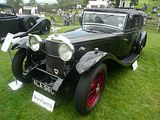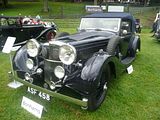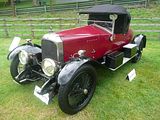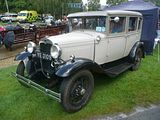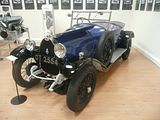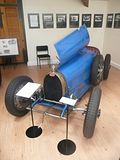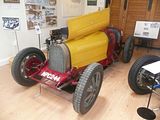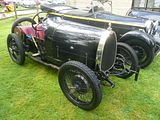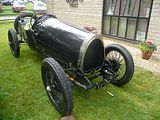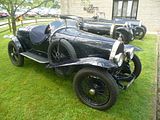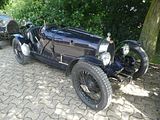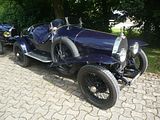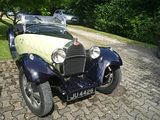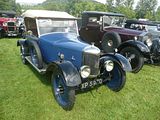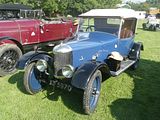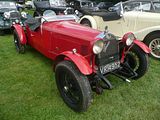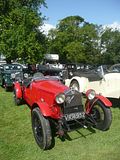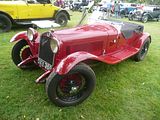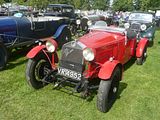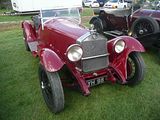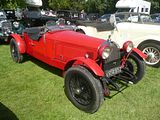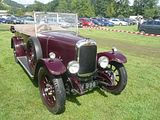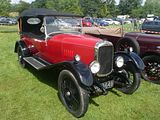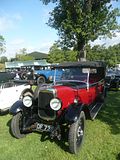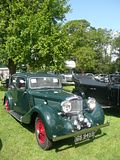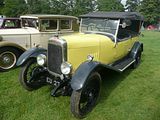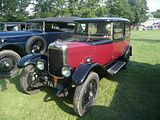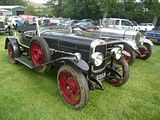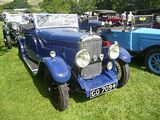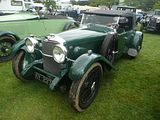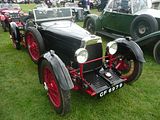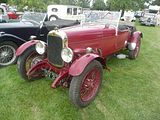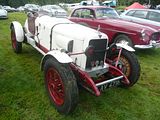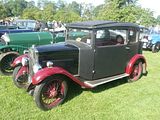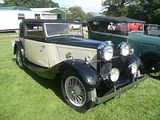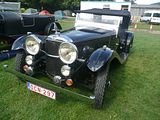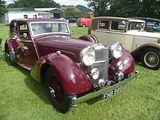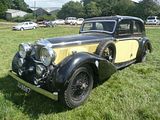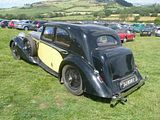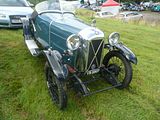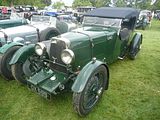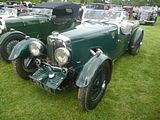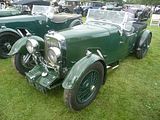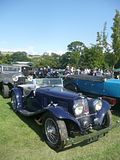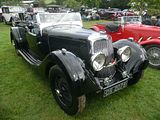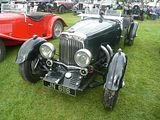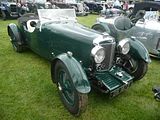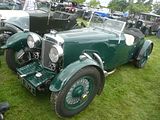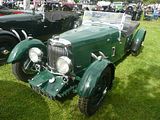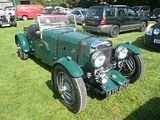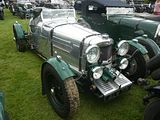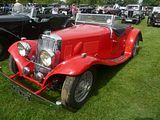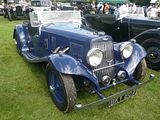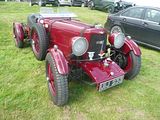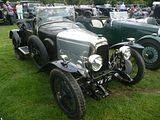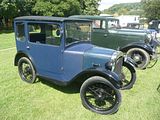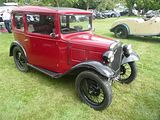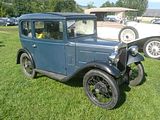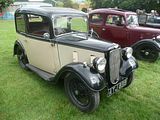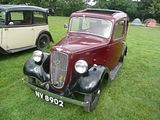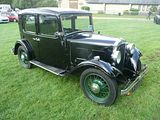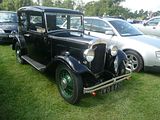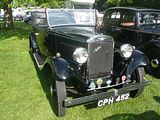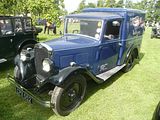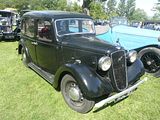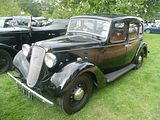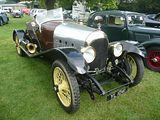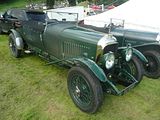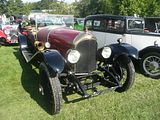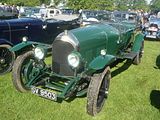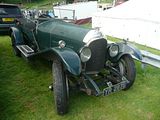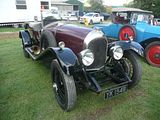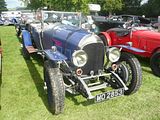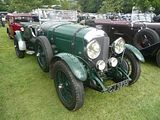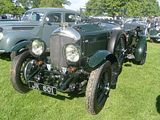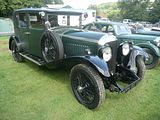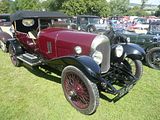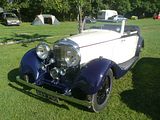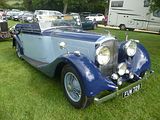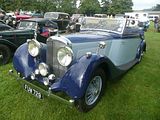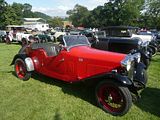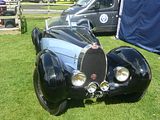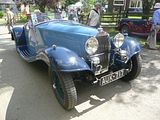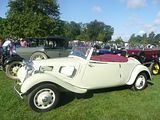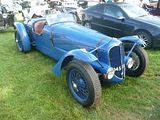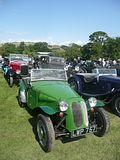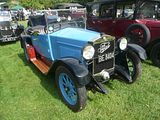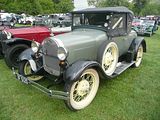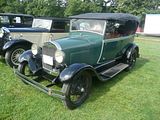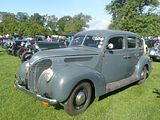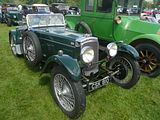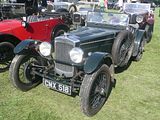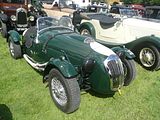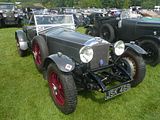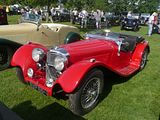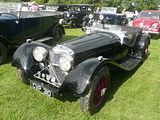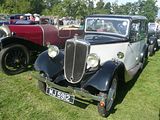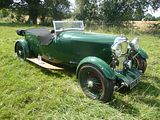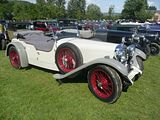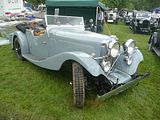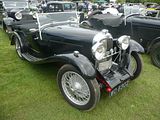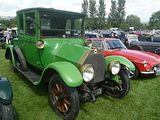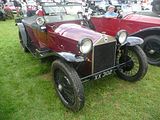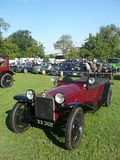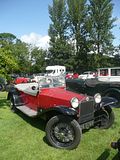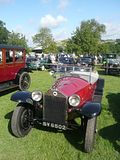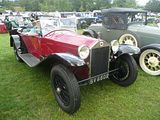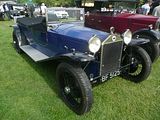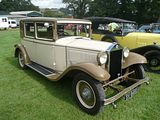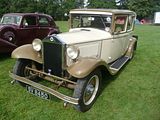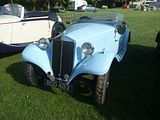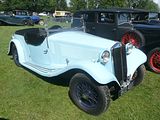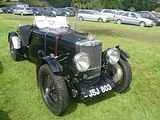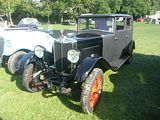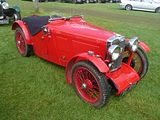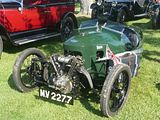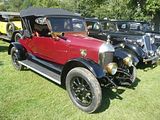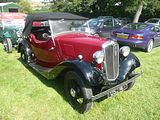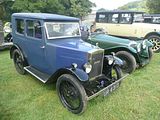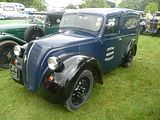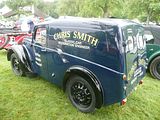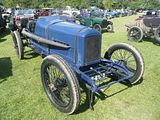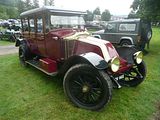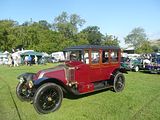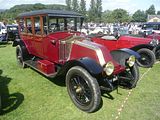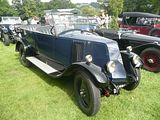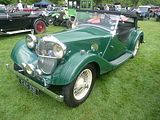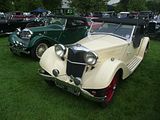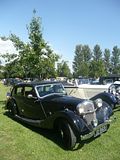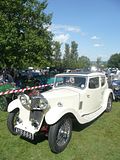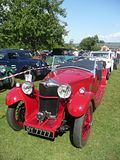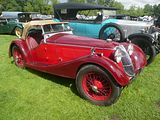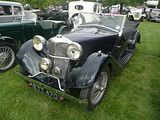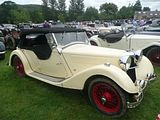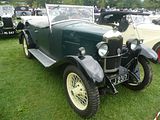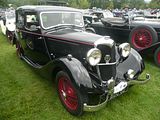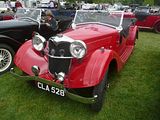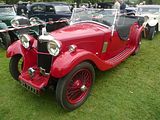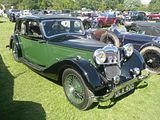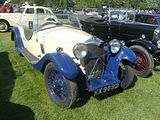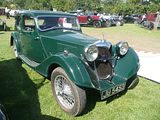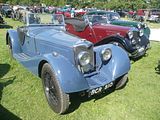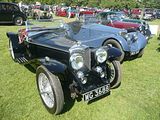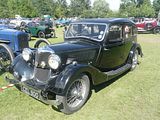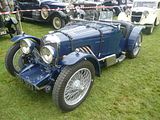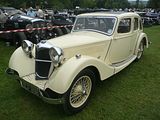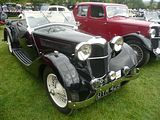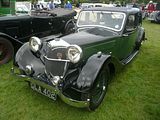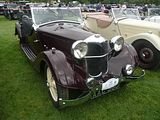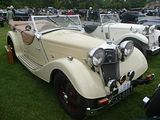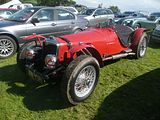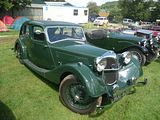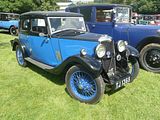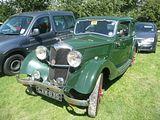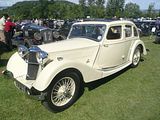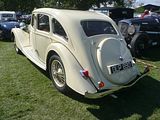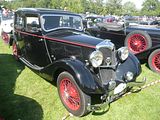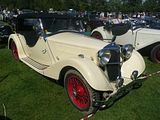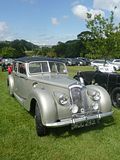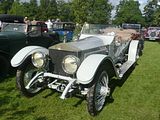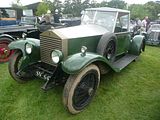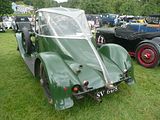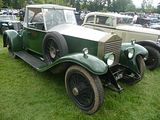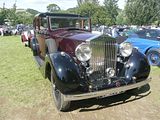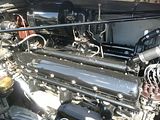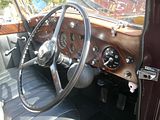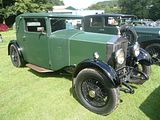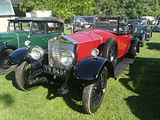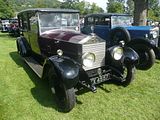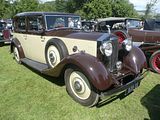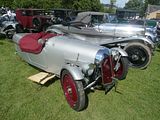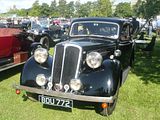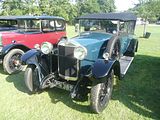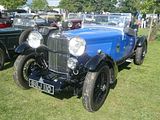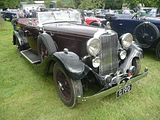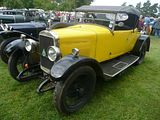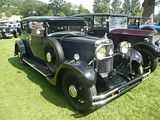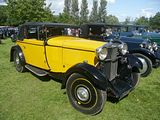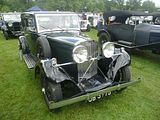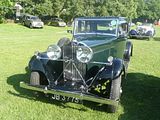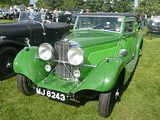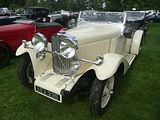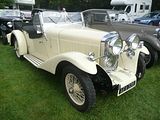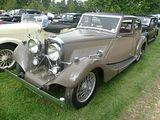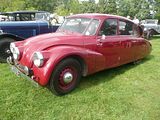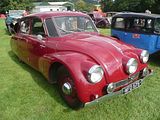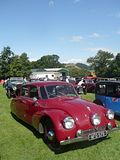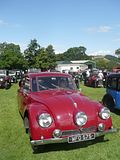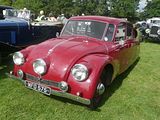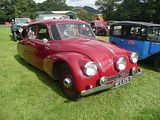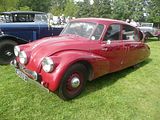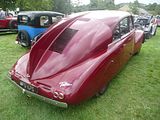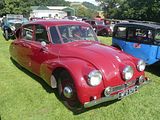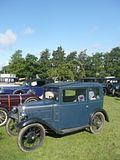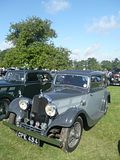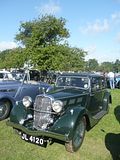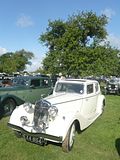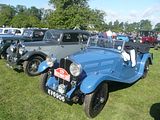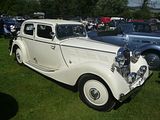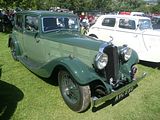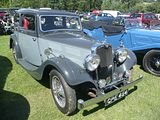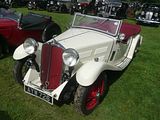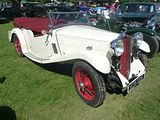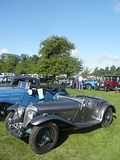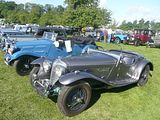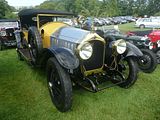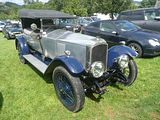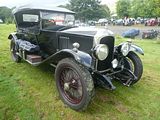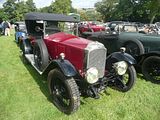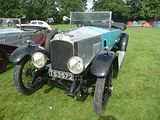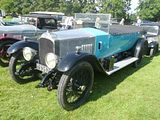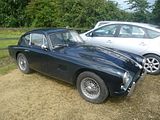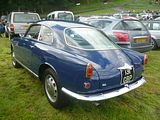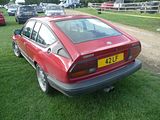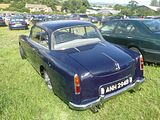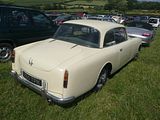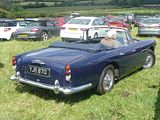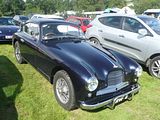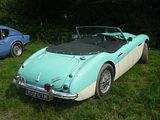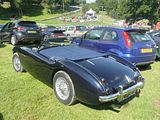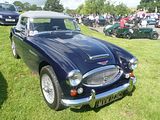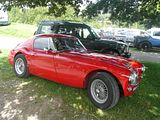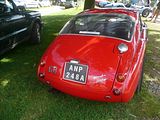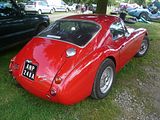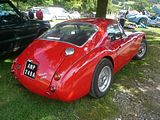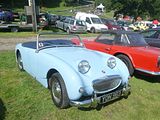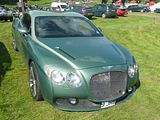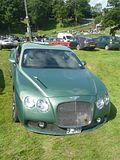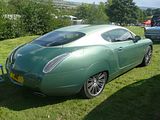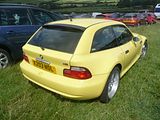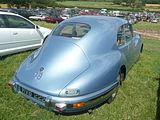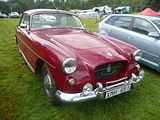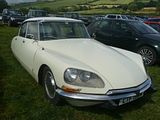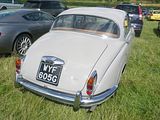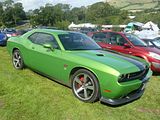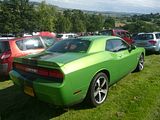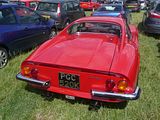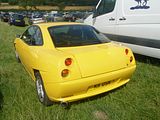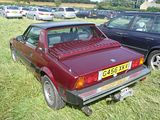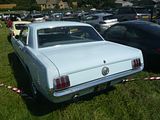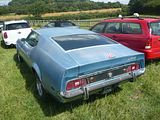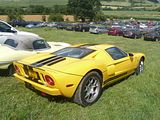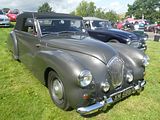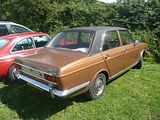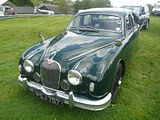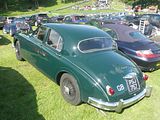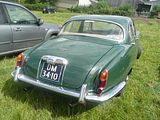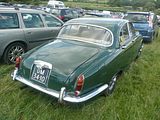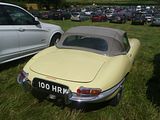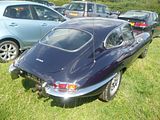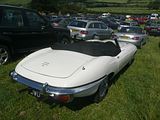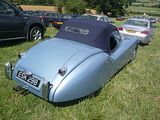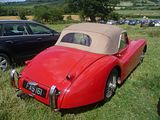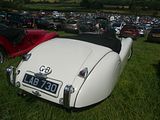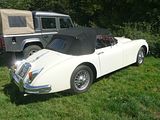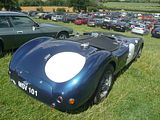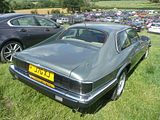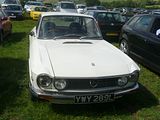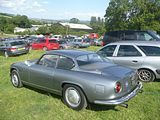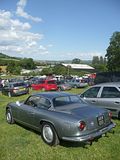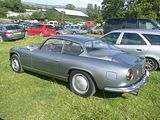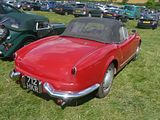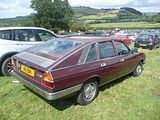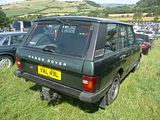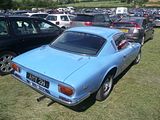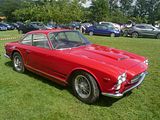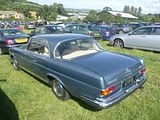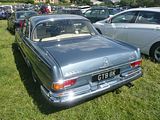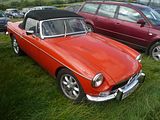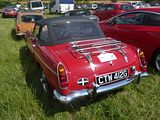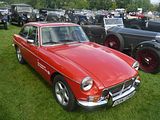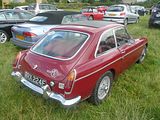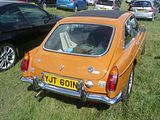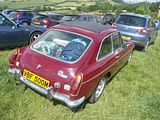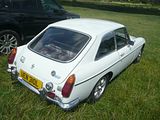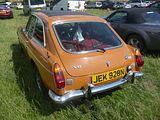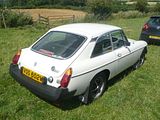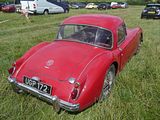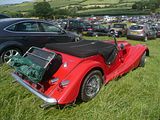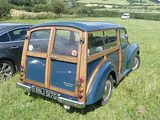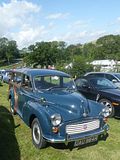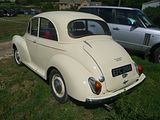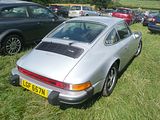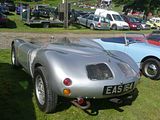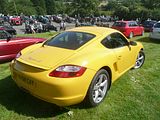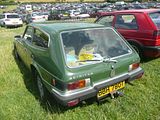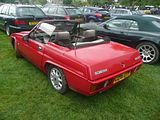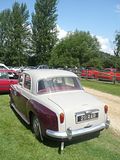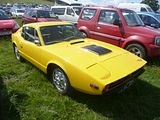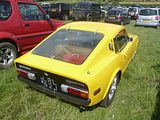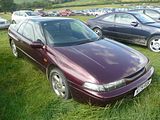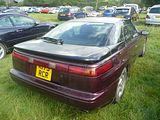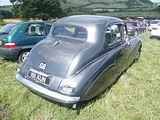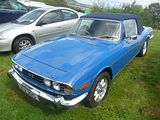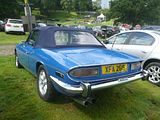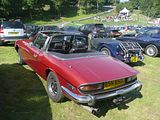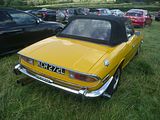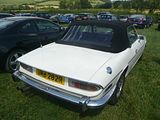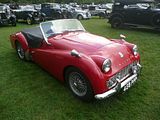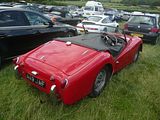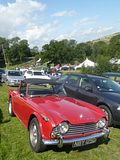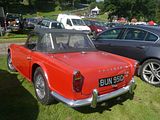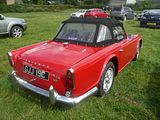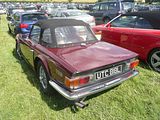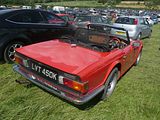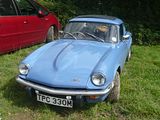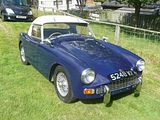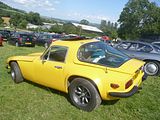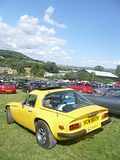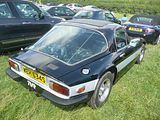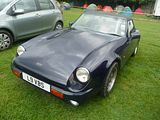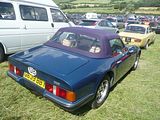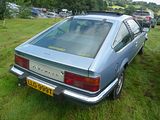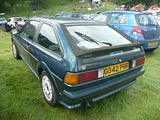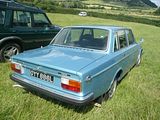2014 marks the 80th anniversary of the creation of the Vintage Sports Car Club, and during the year a number of special events and features have been added to an already busy program to mark this fact. Believe it or not, the VSCC has come to the equally historic Prescott Hill Climb, on the slopes of the North Gloucestershire Cotswold hills no fewer than 71 times, a remarkable achievement in its own right. The first event took place in 1938, and since that time, the VSCC has returned every year bar an enforced hiatus during the war years. VSCC events are popular not just among the Club’s own members but with a far wider selection of the public, who thrill at seeing fabulous historic machines both in action and at rest. It is no exaggeration to say that of all the VSCC events that are held during the year, it is the Prescott meeting in early August which is generally agreed to be the highlight of the annual program. Certainly it is an event that I always enjoy. As a small boy, growing up in Gotherington, I used to love to see all manner of old cars driving or being trailered through the village en route to the Hill, and often used to get out on my bike and head up to the venue to get a closer look. These days, it is pretty much an automatic entry in my calendar when the dates are announced and I am planning out my year. The event usually takes place over both days of the weekend, but this year, as a celebration of that 80th anniversary, a third day was added. Sadly, I was at work and unable to join the Friday meeting, but I did attend on both the Saturday and Sunday, both of which were blessed with some lovely sunshine, though there was also torrential rain the like of which I have never seen in many years of getting wet at this venue! Even the hardy VSCC members had to suspend proceedings for a while on the Saturday afternoon, but 20 minutes after everything getting a soaking, the sun was out and activity was underway again. There was lots to see on both days, as this report will evidence.
IN THE PADDOCK
Unlike some of the other themed events at Prescott, as this meeting is managed by the VSCC, the only cars that go up the hill during the weekend are VSCC cars. 16 separate classes were defined, ranging from some Edwardian machines from over 100 years ago, through the likes of the under 750cc engined Austin Sevens to out and out racing machines of the 1920s and 30s such as the famous Bugatti cars, with practice runs taking place on the Saturday and timed runs on the Sunday. Some cars were entered with more than one driver, so were to be seen in action that bit more than the others. A meander around the Paddock is one of the joys of this event, just taking in the atmosphere created by such an array of historic machinery, all carefully prepared to take on the challenge of the ascent up the hill..
ALFA ROMEO
Some years, there have been several 1930s Alfas at this event, and as these are among my favourite of all 1930s cars, that is a special treat for me. This year there seemed to be just the one competing, a black 6C 1750 dating from 1932.
ALLARD
Although we tend to think of Allards as dating from the late 1940s and 1950s, the marque was around pre war, too. This is a 1938 2 Seater Sports. It has a 3850cc engine.
ALVIS
One of the most popular brands, there were plenty of Alvis models in action. This pair are an SA 16/95 Special and a 12/50 Sports
There were plenty of different models from the Coventry firm. This Silver Eagle Sports car dates from 1929.
AUSTIN
The Seven has long been popular in motorsport, as this affordable little car could easily be tuned or modified to make it go that bit faster. There was a whole class for cars with sub 750cc engines, all of which were Sevens, with a mix of one with the saloon body and a number of the factory built Ulsters and Nippys.
A very different kind of Austin was this, the Austin/Hall Scott EB4, which has a 10 litre aero engine under that long bonnet. It dates from 1911, with the aero engine added later.
BENTLEY
1926 3 litre
BMW
1938 BMW 328
BUGATTI
Prescott is home to the Bugatti Owners Club, so it is no surprise that there were plenty of these fabulous machines in action. The Type 13 and 23 Brescias are always popular and there were several of these cars from the early 1920s.
There were plenty of the Type 35 and 37 models, too.
ERA
Always a highlight of any VSCC meeting are the ERAs present. Three cars were present here: Terry Crabb’s R12C, Donald Day’s R14B and Nick Toplliss’ R4A, driven by James Baxter who took the car to a new record at Shelsley Walsh only a few weeks earlier.
FIAT
This was probably my favourite of the day. Dating from 1905, this Fiat/Isotta Fraschini 200HP had a full 16,5 litre of engine under the bonnet. And bonnet was just about the entire length of the car, with just a small platform at the back for the driver. The whole thing shook when the engine was fired, and the heat generated had scorched the ground below the exhausts. Getting it up the hill required considerable skill, as the thing is not particularly manoeuverable. Fantastic!
FORD
A Bobtail Model T from 1922/8
FRAZER NASH
1934 Frazer Nash Norris Special, with a 3.5 litre engine under the bonnet. Note the chain drive.
There was also an example of the more familiar looking model, though this one has had a Ford engine inserted.
GN
Another outing for the popular GN Spider
LAGONDA
The Rapier was a much smaller and cheaper car that was sold as a separate brand for a year or so before being acquired by the Lagonda Company.
LEA FRANCIS
The Hyper was a light sports car which made its first appearance in 1925 and was the car to put this Coventry marque on the map. Also called the S-type, the Hyper was the first British supercharged production car with a 1.5 litre Meadows engine, and in 1928, one of these cars won the Ulster TT, a 30-lap race on the 13.5-mile Ards circuit on the roads of Northern Ireland in the hands of legendary race car driver, Kaye Don. The race was watched by a record 250,000 spectators, and the victory placed Lea-Francis firmly on the map. There were three of these cars competing, all of them dating from 1930.
MORRIS
One of the more unlikely looking competing cars was this Bullnose Morris. A 1926 Cowley model, it has just 1550 cc to propel it up the hill.
NAPIER BENTLEY
Chris Williams had his very popular 24 litre aero engined Napier Bentley here. True to form, every start was accompanied by clouds of smoke as he wore out another set of tyres.
PEUGEOT
Another of those cars with a huge non-automobile engine under the long bonnet. This one is of 10 litre capacity, and is fitted in a 1913 Peugeot 148.
RAILTON
1935 Light Sports model. This one has a 4.2 litre engine.
RILEY
Lots of Riley cars competing in a number of different classes. The marque dominated the 1101 – 1500cc Class, with a range of 12/4, Sprite, Special and Falcon cars.
This 1935 15/6 Special has a 1725cc engine and thus had to compete in the class for cars up to 3 litres.
SPECIALS
A couple of one-offs that were entered in the under 1100cc pre-war class, a Grannie and a Wasp Single Seater
TALBOT
The Talbot 105 was a high powered sports car developed by Talbot designer Georges Roesch. It was famously fast, described by one authority as the fastest four-seater ever to race at Brooklands. The first of the 6 cylinder Talbot cars made its debut at the London Motor Show in 1926, and at this stage it was formally named according to its fiscal and actual horsepower as the Talbot 14-45. The six-cylinder engine displaced a volume of 1,665 cc and was the basis for all Talbot engines until the Rootes takeover in 1935. The engine was repeatedly bored out further, giving rise to a succession of performance improvements. Throughout these developments, the exterior dimensions of the original 14-45 engine block remained unchanged. The 1930 London Motor Show saw the debut of the 20-70 model, bore and stroke both being increased to give an engine capacity increased to 2,276 cc. In this form the car was later called simply the Talbot 70 or 75. Higher compression ratios and power increases followed. An increase in the engine capacity, still without any change to the exterior dimensions of the engine block, yielded a cylinder displacement of 2,969 cc for the iconic Talbot 105 model. In 1931 four 105s were tuned to provide a reported 119 bhp, at 4,800 rpm. In “Brooklands trim” further tuning and in increased compression ratio of 10:1 gave rise to a claimed 125 bhp. The Talbot acquired its fame on the racing circuits, featuring prominently at Brooklands as well as gaining 3rd and 4th places at the 1930 Le Mans 24hour race. For 1931 Roesch further developed the engine enlarging it to 2,969cc and creating the Talbot 105. The 1931 Le Mans 24hour race saw a Talbot 105 in 3rd place, with prizes on the Alpine Trial in 1931 and 1932. In 1932 Talbot pulled out of racing, but a major Talbot dealer named Warwick Wright successfully ran a team of three 105s that year, and other teams operated by dealers and enthusiasts continued to race the cars at least till 1938. In 1935 Sunbeam-Talbot-Darracq fell on hard times inspite of the good sales provided by the Roesch-designed cars, and was acquired by the Rootes brothers. Three of these legendary cars, in the distinctive livery of apple green were competing here.
TRIUMPH
A couple of Triumphs at the event, both familiar at VSCC meetings: the 1933 Gloria Special and the 1937 Dolomite Special.
VAUXHALL
No fewer than 15 of the 30/98 models were entered.
The earlier Prince Henry was also to be seen competing.
Another of the aero engined cars was this 12 litre Vauxhall Viper Special which dates from 1913. The chassis of this car comes from a Vauxhall C Type, and the radiator from the A Type. Originally it would have had a 4.5 litre 4 cylinder engine, but that has been replaced by an 11,778cc V8 Hispano Suiza engine. This engine was significant, as built under licence as the E4 by Wright Bros, it was the first truly reliable engine of WW1, and its meant that pilots of SE5s could get home across the Channel rather than being stationed in a field in semi-occupied France. Previously, engines had needed rebuilding after every 1 hour of flying time, so naturally everyone wanted one of these. It was very advanced for its time, all-alloy in construction with steel liners and hollow rods, and a bevel drive camshaft on each bank. There are two Scintilla magnetos, each firing a plug in each cylinder, one each side, the idea being that if one magneto fails, you still have a viable engine, and hence stayed in the air. The compression ratio is only 5:1. It was designed to run at a constant 1800 rpm, but with 2 SU carburettors, it has been dyno-ed at 300 bhp and 700 lb/ft at 1500rpm. 1800 rpm equals 120 mph in top, and the car has been clocked at 116 mph at Donington. The engine will ref a lot more than that. Around 20,000 examples of the engine were built, so there are still plenty around. The one in this car was rebuilt by the Shuttleworth Collection. According to the owner, the gearbox on this car, which comes from a Vauxhall D Type, is the weak point. It used to overheat, as well, but an extra radiator sorted that out. You see it at plenty of events in the UK. but it’s been further afield, taking part in a recreation of the Targa Florio in Sicily in 2013. Only once has it been crashed, at Angouleme, in France in 2009. It can be used as a touring car, though the fact that it does an average of 4mpg makes the range rather limited.
WOLSELEY
There were a couple of Hornet Special cars from 1934
HISTORIC BMW DISPLAY
To celebrate the 80th anniversary of the agreement which saw BMW’s marketed and sold in the UK by Frazer Nash, a special display of historic Frazer-Nash BMWs was presented which made for a particularly interesting addition to the usual collection of cars seen here. Frazer Nash was, of course, a marque in its own right, making small chain driven sports cars, with proprietary engines which enjoyed much sporting success, including the prestigious Coupe des Alpes. By the mid 1930s, though, their design with beam axles and a channel section chassis was limiting their performance. Things came to a head in 1934, when immediately after their cars were beaten in the 1934 Coupe des Alpes by a trio of BMW 315 2 seaters, the then Company owner, manager and works driver, HJ Aldington, went straight to the BMW factory in Munich to negotiate the importation of right hand drive versions of the cars which had defeated his own. An agreement was struck and announced in December 1934 for the cars to be called Frazer Nash BMWs.. Aldington brought back a 315 two seater sports cars to the UK, still in left hand drive form. Registered BMP844, this was one of the actual Alpine Trial Team cars. Many more 315s and the outwardly similar 319s would follow., and several of these were on show.
Although it was the 2 seater sports 315 that had piqued HJ Aldington’s interest, there were plenty of other models in the range, which, ironically, had grown largely as a result of the Bavarian company making British cars under licence, with the Austin Seven based Dixi some years earlier. The first right hand drive cars that came in were the 315 and 319 saloon models, These looked the same and were supplied with a mix of 1.5 and 2.0 litre engines, some with two and some with three carburettors, all with iron heads and vertical valves.
In 1936, though, the 328 appeared with a light alloy cylinder head and inclined valves in hemispherical combustion chambers and three carburettors. This turned out to be extremely efficient and the engine was copied by Bristol Cars after the Second World War. The 328 was particularly successful in all forms of motorsport from rallies to road racing, as well as hill climbs. There were a number of the well known 328 at this event.
By this time production of the chain driven Frazer Nash cars had ceased as the advantages of BMW’s design were indisputable, with outstanding ride and road holding for their day. This was thanks to a stiff tubular chassis, independent front suspension and rack and pinion steering. The early cars – 315, 319 and 329 – had cable brakes and a 6 volt electrical system. Later models had a box chassis with semi-elliptic rear springs. Many of the early cars had aluminium panels over ash frames, but later cars would have all steel bodies. All had the benefit of a foot operated one-shot chassis oil lubrication system. The cars were very advanced compared to what else was on the market at the time, but they were expensive. Even so, more than 700 cars were brought into the UK before the Second World War. During the 1930s, new models continued to be added to the range, with the 326 Saloon and the 327/80 drophead coupe being particularly stylish. Around 60 cars came to the UK in chassis form and were bodied by various English coachbuilders, in particular Abbots of Farnham, Whittingham & Webb with a 326 Saloon by Freestone & Webb and a 320 Saloon by Midland Motor Bodies. These English bodies came in both open and closed versions. A 326 with Freestone & Webb body was present in this display along with a couple of regular 326 saloons and several of the 327/80 Cabriolets.
World War 2 interrupted everything of course. When peace returned, one BMW factory was now behind the Iron Curtain, with cars made in the Eisenach plant now being called EMWs. Few were made, but there was an example of one of these, an EMW 327/2 on show here.
Post World War 2, Frazer-Nash BMWs were understandably not very popular as people knew where the cars originated, and so the agreement between AFN and BMW was not pursued Bristol Cars supplied engines to AFN and their new 400 model looked ever so similar to a 327/80 Coupe. Although the 328 retained its fans, by the late 1950s, there were very few Frazer Nash BMWs still on the road, as most people could now afford a newer car. Gradually the next generation of enthusiasts emerged, and their interest in marques of the 1930s led to a renaissance in interest for the Frazer Nash BMWs. Although the cars had originally been in the remit of the BMW Car Club, this new found interest ultimately led to the formation of a Club specifically for the marque, the BMW Historic Motor Club, and it is cars from this which were assembled for this most impressive display.
DAVID BROWN SPEEDBACK
This was the first chance I have had to see the David Brown Speedback, a modern take on the classic Aston Martin DB5. The car made its debut in Monaco in April this year, and my initial reaction – shared by many others, at the time, it seems – was that the styling did not seem quite to work, and that if the car’s eponymous founder (no relation of the original David Brown who owned Aston Martin in the 1950s through to the 1970s) thought that even 100 people would want to part with £600,000 for this pastiche car, then he was far more optimistic than me. However, when you get to see it in the open rather than the studio, and to see the sumptuously produced interior, you will probably change your mind. I certainly did. Based on the underpinnings of a modern Jaguar XK, the styling does remind you of the iconic DB5, but it is sufficiently different to persuade you that it is a design all of its own, and it looks good from most angles. The interior really does look and feel special, befitting the price tag. Unexpected party trick is at the back of the car. As well as a large conventional tailgate, there is a small drop down flap and then you can flip up the rear-facing seat, which would be just perfect for an event like this. £600,000 is an awful lot of money, but I am now far more convinced that selling the planned 100 units may not be that hard after all.
BONHAMS AUCTION CARS
Bonhams had a special display of cars that would be featuring in auction sales that they would be holding in the coming weeks
1934 SS1 Jaguar.
1933 Alvis Speed 20 SA Tourer
There was a second Alvis, a 1937 4.3 litre Drophead Coupe
This 1920 “E” Type Vauxhall 30/98 has unusual Grosvenor two seater plus dickey coachwork. This car has not left Norfolk for more than half a century, and it was estimated that it would sell for around £150,000.
OTHER DISPLAY CARS
This was a very nice 1930 four door version of the Model A Ford, the car that had the almost unenviable task of taking over from the long running Model T in 1927.
BUGATTI TRUST
The Bugatti Trust museum was open all weekend, so it was a good chance to get an update as to what is crammed into this small building. As well as a number of complete cars, there is all sorts of memorabilia associated with the marque.
A number more cars were parked up outside the building.
IN THE VSCC CAR PARK
With a part of the Orchard reserved on the Saturday, and the entirety of it on the Sunday for VSCC member cars that were not actually participating on the hill, you could easily spend your entire day just wandering around here, marvelling at the vast number, variety and condition of an array of splendid machines, some of which are family and easy to recognise and a few of which have even those more knowledgeable than me scratching their heads.
AC
With a curved grille that is not unlike that of the better known Bullnose Morris, the AC 12hp of 1920 – 1927 was offered with 1.5 litre and 2 litre engines. Around 1800 were made. A couple of them were on show here.
ALFA ROMEO
I was delighted to find a number of further examples of the lovely 6C 1750, some of which I don’t recall seeing before.
ALVIS
Lots of Alvis models, from the extensive catalogue of offerings of this British marque.
AMILCAR
The original Amilcar was a small cyclecar. Designed by Jules Salomon and Edmond Moyet, it bore a striking resemblance to the pre-war Le Zèbre. The vehicle was first exhibited at the Paris Motor Show in October 1921., and the business was a leading beneficiary of a cyclecar boom, prompted by a government initiative which held out the promise of a reduced rate of annual car tax, fixed at 100 francs per year, for powered vehicles weighing no more than 350 kg (dry weight, without fuel or water or such extras as a spare tyre/wheel), providing seating for no more than two people and powered by an engine of not more than 1100cc. Once a vehicle exceeded these limits it ceased to be a cyclecar and was instead officially designated a voiturette. The 4-cylinder 903cc Amilcar CC appeared in 1922, with a wheelbase of just 91 inches The CC subsequently became available in two further versions; the Amilcar C4 was a slightly longer sports car, while the CS, introduced in 1924, was a brisker sports version with the engine size increased to 1004 cc. The side-valve engine had splash lubrication, and came with a three-speed gearbox. The most famous model of all was the CGS “Grand Sport” of 1924; this featured a 1074 cc sv engine and four-wheel brakes. This in turn evolved into the more sporty CGSS “Grand Sport Surbaissé”. These models were built under license in Germany (as the Pluto) and in Austria (as the Grofri) and in Italy (as Amilcar Italiana). The marque entered automobile racing in the mid-1920s with a batch of supercharged dohc 1100 cc six-cylinder cars that used a roller bearing crankshaft in the full racing version; these vehicles were also available with plain bearings, driven by famous race driver André Morel. later diversifications into larger models were largely unsuccessful, and it is the small cars of the 1920s like the one here for which the marque is best known these days.
ASTON MARTIN
There were a nice line up of historic Astons, ranging from the 1.5 litre and International cars to the 15/98.
Included among them was Green Pea, the oldest surviving Aston that dates from 1923, which we saw a number of times during the marque’s centenary year in 2013.
AUSTIN
There were a number of the delightful little Seven model, showing the wide range of different bodies that were offered in the seventeen year life of Herbert Austin’s masterpiece. Early and boxy saloons were joined by some of the later cars here.
Sitting above the Seven and below the various Twelves in the Austin range was the Ten, which was a medium sized car, first launched on 19 April 1932. This was Austin’s best-selling car in the 1930s and continued in production, with upgrades, until 1947. The design of the car was conservative with a pressed steel body built on a cross braced chassis. The chassis was designed to give a low overall height to the car by dipping down by 2.75 inches (70 mm) between the axles. The 1125-cc four-cylinder side-valve engine produced just 21 bhp and drove the rear wheels through a four-speed gearbox and open drive shaft to a live rear axle. Steering was by worm and wheel. Suspension was by half-elliptic springs all round mounted on silent-bloc bushes and damped by frictional shock absorbers. The four-wheel brakes were cable and rod operated by pedal or by hand lever on the offside of the speed lever. The electrical system was 6 volt. For the first year only, a four-door saloon was made in two versions. The basic model cost £155 and was capable of reaching 55 mph with average fuel economy of 34 mpg; and this was rapidly followed by the Sunshine or De-Luxe with opening roof and leather upholstery at £168. Bumpers were provided. 1933 saw the saloons joined by an open two-seater or Open Road tourer, a Colwyn cabriolet and a van. A sports model, the 65 mph, 30 bhp Ripley joined the range in 1934. Mechanical upgrades for 1934 included a stronger chassis, synchromesh on the top two gears and 12-volt electrics. The Ripley was a close-coupled four-door tourer with lowered front doors and no running boards. Improved engine breathing—Zenith downdraught carburettor, revised manifolds and camshaft—all combined to improve engine output to 30 bhp.
The first styling change came in August 1934 with a change to the radiator when the plated surround or cowl was replaced by one painted in body colour and it was given a slight slope. Synchromesh was added to second gear and dual screenwipers, flush-fitting self-cancelling trafficators (worked by the steering) and a foot-operated headlamp dip switch were fitted. The engine controls were simplified by the adoption of automatic ignition, compensated voltage control, and the provision of a “choke” (combined strangler and throttle control). The saloon was given the name Lichfield and got a protruding boot which enclosed the spare wheel. During 1935 the friction dampers were replaced with hydraulic dampers. A new six light (three windows down each side, with one behind the rear door) Sherborne body style was added in January 1936, the roof line swept to the rear without interruption to provide a flush back, the then fashionable ‘Airline’ style. The new seating was extra deep at the rear, now with armrests and somewhat longer from back to front than on previous models. The new Sherborne with fixed or sliding roof was priced at £10 more than the equivalent Lichfield.
A much bigger change came in December 1936 with the release of the almost streamlined Cambridge saloon and Conway cabriolet. Compared with the preceding cars the passengers and engine were positioned much further forward, the back seat now being rather forward of the back axle. There were six side windows like the Sherborne and the quarter lights were fixed. Again like the Sherborne the forward doors opened rearwards. At the back there was now a compartment large enough to take a trunk as well as more luggage on the open compartment door when it was let down. A new smoother single plate spring-drive clutch was now fitted, the two friction rings carried by the centre plate were held apart by leaf springs. Other changes included Girling brakes with wedge and roller shoe expansion and balance lever compensation using operating rods in tension with automatic compensation between front and rear brakes all four of which might be applied by hand or foot. Drums were now 9 inches diameter. 16″ steel disc wheels replaced the 18″ wires Top speed rose to 60 mph The car’s wheelbase was now ¾ inch, longer. Rear track was now increased to 3′ 10½”, The vehicle’s weight was now reported to be 18½ cwt, The Times, when they had a car on test, commented favourably on the new clutch, saying no previous Austin clutch had engaged smoothly and added “the car is built for steady economical running rather than for speed or brilliance”. These changes did not appear on the open cars, which no longer included the Ripley sports, until 1938 when the Cambridge and the Conway cabriolet gained an aluminium cylinder head on the engine and a higher compression ratio. This is a 1937 example
BENTLEY
There were plenty of the majestic 3 and 4.5 litre models that the Crewe-based company made between 1919 and the early 1930s.
After the acquisition of Bentley by Rolls-Royce, in 1934, the focus of the brand shifted to the production of large and elegant tourers. These cars are generally referred to as the “Derby” cars, as that is where they were built. Featuring 3.5 and 4.5 litre engines, they were supplied as a chassis for the customer then to choose a body style. Many were bodied by Vanden Plas, but there is considerable variety in the cars that were produced. Of 2500 such cars made before the War, about 1500 still survive and many of them are very elegant indeed, and some of that variety was evident in the cars that were on show here.
The post war Mark VI and R Type models suffered somewhat from the shortage of available materials, and their bodies were of rather poor quality, with many rusting quite quickly. This meant that quite a few underwent a transformation into the Special, with cut down,and more sporting appearances than the rather stately way they left the factory. Here is an example.
BUGATTI
CITROEN
Citroën made around 81,000 of these lights cars between 1922 and 1926. Originally called the Type C, it was updated to the C2 in 1924 which was in turn superseded by the slightly longer C3 in 1925. The Type C was, and still is, also well known as the 5CV due to its French fiscal rating of its engine for taxation purposes. More colloquial sobriquets, referring to the tapered rear of the little car’s body, were ‘cul-de-poule’ (hen’s bottom) and ‘boat deck Citroën’. Only open bodies were made with the original Type C, often nicknamed the “Petit Citron” (little lemon), due to it only being available in yellow at first, as one of the more popular variants. The C2 tourer was a two-seat version but the C3 was a three-seat “Trefle” (Cloverleaf) three-seat model with room for a single passenger in the rear. There were also C2 and C3 Cabriolets made. This particular three seater looked like it had been recently restored and was absolutely pristine.
Also nice was this open version of the Traction Avant
CROSSLEY
Rather splendid was this Crossley Van.
DELAHAYE
DELLOW
Dellow made a series of relatively low cost cars in the late 1940s and early 1950s, based on trusty Ford mechanicals which became very popular for low cost motor sport and which could also be used as an every day car.
FIAT
There’s no mistaking the marque here, with Fiat writ large across the grille.
FORD
There were another couple of examples of the Model A, both here in open topped Tourer guise.
Ford made waves when they announced the fitment of a V8 engine in the replacement for the Model A. Rather than call it the Model B. it was known, rather imaginatively as the V8. A vast array of different body styles were offered.
I’ve seen this car at many events in recent times, and always thought that it dated from the early 1940s. There are no badges on it, and there’s never been any information, but I can now correctly assert that this is a 1938 Model 81a Four Door De Luxe. Time to go and correct some earlier reports!.
FRAZER NASH
Chain driven Frazer Nash.
A small number of Frazer Nash cars were made after the war. This is the Le Mans Replica, 34 of which were made between 1948 and 1953., It featured a 2 litre 6 cylinder Bristol engine.
INVICTA
JAGUAR
A couple of very nice SS100 Jaguars. Neither of them, sadly, are original 1930s cars, but the Suffolk recreations, which. it has to be said, are extremely faithful in just about every visual detail, to the original cars.
JOWETT
One of the more unusual cars of the day was this, an example of a pre-war product from the Bradford based Jowett company. Although Jowett had been building cars for some time it was not until 1936 that a model with a four cylinder engine was offered. Not one to be conventional, it was a a flat four with twin carburettors, and an engine of 1166 cc, and was called the Jowett Ten. Production of the traditional twin-cylinder models which grew to 946 cc in 1937 continued until the war intervened.
LAGONDA
Rapier
LANCIA
One of the most striking cars of the entire event was this, a very imposing Lancia. I’ve not been able to find out exactly which model it is. Information gratefully received!
More familiar is the Lambda, an innovative car which was first shown in 1922. A number of these were present. Built in 9 series over a 10 year period, the Lambda pioneered a number of technologies that soon became commonplace in our cars. For example, it was the first car to feature a load-bearing monocoque-type body, (but without a stressed roof) and it also pioneered the use of an independent suspension (the front sliding pillar with coil springs).Vincenzo Lancia even invented a shock absorber for the car and it had excellent four wheel brakes. The narrow angle V4 engine which powered is not something which was widely copied. Approximately 11,200 Lambdas were produced. Most of them had the open Torpedo style body, but some of the last Series 8 and 9 cars had Weyman saloon bodies.
This is a 1930 Artena Berlina. The Artena was produced between 1931 and 1936, powered by a 2 litre Lancia V4 engine. There were four successive versions of the car. Lancia built approximately 1500 of the first series between autumn of 1931 through summer of 1932. During the next year the second series was produced, and the third series from Autumn 1933 till the start of 1936. The third series was available in two lengths. The 54 bhp engine was sufficient to provide a claimed maximum speed of 72 mph for each of the first three versions. Between 1940 and 1942 a further 507 Artenas were built. These modified Artenas were larger and slower than the prewar versions: they were used by senior military and political personnel, and in modified form as ambulances.
This is a rare open topped version of the late 1930s Aprilia
Also here was a smaller 1934 Augusta model, in open tourer guise.
MG
There were a number of the 18/80 models, a large 6 cylinder car that was sold in the late 1920s.
Far smaller was this M Type.
1935 Magnette
The T Series first appeared in the late 1930s and a small number of TA and TB models were made before the war interrupted production. When things got underway again, the TC proved to be particularly popular with American GIs, such that more TCs were produced than all MGs before hand.
MORGAN
Three-wheeler from the 1920s.
MORRIS
The unmistakable shape of the Bullnose grille makes it easy to recognise this as a Morris. The design lasted well into the 1920s.
Mainstay of the range in the 1930s was the Eight, which was offered in a wide variety of different body styles, of which this tourer was one of the more popular ones.
Cheaper than the Eight was the Minor, and this one has a fabric body which was another cost cutting measure that was not especially popular then (or now!).
Following the launch of the Series E version of the Eight in 1939, Morris produced a Van version, rated at 5 cwt capacity and designated as the Series Z. It was produced from 1940 to 1954. While having the external appearance similar to the Series E, mechanically the vans were more akin to the Series II, still having a three speed gearbox. Over 51,000 examples were built. They were popular with organisations like the GPO who had a large fleet of them.
PEUGEOT
RAPIER
RENAULT
RILEY
Stretching the time period into the immediate post War, was this RM Series Saloon.
ROLLS ROYCE
40/50 Silver Ghost
I’d never seen this car before, as if I had, I would surely have remembered. “Striking” does not get close to describing the appearance thanks to the unusual perspex canopy. The chassis is a 1927 Rolls-Royce Twenty, the “small” car that Rolls Royce introduced in 1922, to sit beneath the 40/50 “Sliver Ghost” and later Phantom models in their range. It was intended to appeal to owner drivers but many were sold to customers with chauffeurs. The Twenty featured a new inline-6 cylinder overhead valve engine, designed for the car, of 3127 cc. Unlike the Silver Ghost engine, the cylinders were cast in one block and the cylinder head was detachable. Both coil and magneto ignition were fitted. The early cars had 3-speed manual gearboxes with the change lever in the centre of the car, but this changed in 1925 to a four-speed unit with traditional right-hand change. The power was transmitted to the rear axle via a standard propeller shaft with a universal joint at each end. The substantial chassis had rigid front and rear axles suspended by half-elliptic springs, with braking initially only on the rear wheels. Four-wheel brakes with mechanical servo were introduced in 1925. The famous Rolls-Royce radiator with triangular top was fitted, and early examples had enamel-finished horizontal slats, later changing to a nickel finish and finally becoming vertical. In 1920 a chassis cost £1100 with, typically, a complete tourer-bodied car costing around £1600. With coachwork to the factory recommended weight the car could reach 60 mph, but many owners had large limousine bodies fitted, with the inevitable detrimental effect on performance. Only the chassis and mechanical parts were made by Rolls-Royce. The body was made and fitted by a coachbuilder selected by the owner. Some of the most famous coachbuilders who produced bodies for Rolls Royce cars are Barker, Park Ward, Thrupp & Maberly, Mulliner and Hooper.. This one is quite unlike any other. It started life as a 1927 model, which was shipped to the US. In 1929 a second hand engine, some suspension and wheel components were sent out for the car. It is not known why these were needed (judging by the parts required the car may have been in a crash?). In 1933/34 a new streamlined body was fitted in Boston by Tecton, a Boston company, for the owner Alan Beamish. The car was designed to pull aircraft into the air. It was given an aluminium body with Plexiglas (Perspex) rear windows. These were fairly new materials in the 30’s. The dashboard was made of cast aluminium. The car had a fin shape at the rear and a tow hook on the back. The roof had Perspex panels. The body number is thought to be GUJ52. Presumably the shape and very clear rear visibility were designed to make towing an aircraft easier. Alan Beamish had a racetrack in his garden and used it to hold races. In the 1950’s the car went to Rhodesia. At the time of the independence of Southern Rhodesia (Now Zimbabwe) it went to South Africa, firstly to Johannesburg and then to Capetown. It was later moved to London and sold, and has for a while been part of the private vintage car collection at the Awentsbury Hotel, Selly Park, Birmingham. .
A particularly splendid Phantom III
There were a number of other classic Rolls Royces from the 1920s and 1930s.
This very imposing Silver Wraith dates from the late 1940s and shows the cautious evolution of body styling from the 1930s.
SANDFORD
Looking very like a three-wheeler Morgan, this is in fact a 1934 Sandford S Grand Sport. When Englishman Stewart Sandford moved to Paris, he found a job selling Morgan automobiles. As all Morgans at the time had three-wheels and a two-cylinder engine, this allowed them to fall in the motorcycle tax-code category giving them a price advantage over many other ‘automobiles’ of the time . When customers began requesting ‘cycle-cars’ with a more powerful engine, Sandford saw an opportunity to meet their demands. His four-cylinder, three-wheeled cycle car arrived on the market in 1922 and drew its design inspiration from the Morgans. There were differences, such as the Sandford’s steel frame instead of the wood frame of Morgan. The four-cylinder engine, created by Ruby, was available in both naturally aspirated and supercharged form. In normally aspirated form, the 1098cc water cooled Ruby engine put out 35bhp. The power produced by the engine was sent to the rear wheel via a two-chain system. Shifting is done with the left hand; a lever is located on the right side of the driver which operates a brake. A foot brake is also available to help keep the car in the drivers control. The interior has room for a driver and a passenger. In the pre-War era, the second seat was usually occupied by a driving mechanic who served double-duties as a counter weight, keeping the car from flipping over in the corners. Top speeds were reported to be over 100 mph and nearing the 115 to 120 mph range, which made this a very dangerous machine in corners. Sandford automobiles were produced in limited numbers, with around 50 examples being produced in a year. In 1936, the Ruby Engine Company was bought by a Sandford competitor which was devastating for Sandford. Within a short period of time, Sandford was out of business.
STANDARD
Like most brands that were producing cars in the 1930s, Coventry-based Standard offered quite a wide of range of models, some of which are better known that others. In 1936 the entire range was replaced by a more aerodynamic design which was known as the Flying Standard. Offered as a Nine, a Twelve, a Sixteen, a Twenty and a V8, this is an example of the 2.7 litre Twenty.
SUNBEAM
There were plenty of examples of the large Sunbeam cars that were sold in the 1920s.
TALBOT
Talbot was originally the British marque used to sell imported French Clément-Bayard cars. Founded in 1903, this business venture was financed by Charles Chetwynd-Talbot, 20th Earl of Shrewsbury and Adolphe Clément-Bayard. Starting in 1905, the company sold imported cars under the Clément-Talbot marque and began assembling French-made parts at a new factory located in Barlby Road, Ladbroke Grove, North Kensington, London, selling them under the name Talbot. Domestically-designed cars followed from 1906. By 1910, 50 to 60 cars a month were being made. A Talbot was the first car to cover 100 mph in 1913. During World War I, the firm manufactured ambulances. French and British operations continued in separate, parallel production and marketing processes until 1919, when British-owned but Paris-based Darracq took over the company; Darracq-made Talbots were marketed as Talbot-Darracqs. The following year, Darracq was reorganised as part of the Sunbeam-Talbot-Darracq (STD) conglomerate. In 1935, the STD combine collapsed and the Rootes Group took over Clément-Talbot. For Rootes, immediate sustainability was more important than re-engineering – the existing models were simply rebadged. The French factory was bought by Antonio Lago who used Talbot-Lago as a marque afterwards. In Britain, Sunbeam and Talbot marques were combined in 1938 to form Sunbeam-Talbot. Production of Sunbeam Talbot automobiles ceased during World War II and resumed again in 1946, and the Talbot name was dropped in 1955. The Sunbeam name continued under the Rootes management (Rapier, Alpine and Tiger) until 1967 when control was taken over by Chrysler. As well as the famous 105 cars that were competing for honours on the hill, there was another one in the Orchard, along with a number of those 1930s Talbot badged cars were on shown here, including a 1936 Ten.
TATRA
This spectacular 1946 Tatra T87, belonging to Octane writer Delywn Mallett, was something of an attention grabber. Launched in 1936, and produced for 4 years, the Czechoslovakian car was praised by German officers in World War II for the superior speed and handling it offered for use on the Autobahn. It was powered by a rear-mounted 3.0-litre air-cooled 90-degree overhead cam V8 engine that produced 85 horsepower and could drive the car at nearly 100 mph (160 km/h). It is ranked among the fastest production cars of its time. Competing cars in this class, however, used engines with almost twice the volume, and fuel consumption of 20 litres per 100 km (11.8 mpg), but thanks to its aerodynamic shape, the Tatra has a consumption of just 12.5 liters per 100 km (18.8 mpg). The Nazi armaments and munitions minister Fritz Todt declared: “This 87 is the Autobahn car …” Much of this was down to the streamlined shape, which was designed by Hans Ledwinka and Erich Übelacker, and was based on the earlier Tatra 77, the first car designed for aerodynamic purposes. The body design was based on proposals submitted by Paul Jaray of Hungarian descent, who designed the famous German Graf Zeppelin dirigibles. A fin in the sloping rear of the Tatra helps to divide the air pressure on both sides of the car, a technique used in later aircraft. Tatra T87 had a drag coefficient of 0.36 as tested in the VW tunnel in 1979 as well as reading of 0.244 for a 1:5 model tested in 1941. Small sets of windows in the dividers between the passenger, luggage space and engine compartments, plus louvres providing air for the air-cooled engine, allowed limited rear visibility. Its entire rear segment could be opened, to service the engine. The front doors are “suicide doors” (i.e. rear-hinged doors), whereas the rear doors open in an orthodox manner.Many design elements of the Tatra 87, and the follow on Tatra V570 and later T97 were subsequently copied by other car manufacturers. Ferdinand Porsche was heavily influenced by the Tatra 87 and T97 and the flat-four-cylinder engine in his design of the Volkswagen Beetle, and was subsequently sued by Tatra. The price new (in 1940s) was 25,000 SFr., and now these cars are worth Big Money, fetching around $125,000 when they come up for sale.
TRIUMPH
Having started off producing smaller models such as the SuperSeven to compete against the market dominating Austin and Morris models, by the early 1930s, Triumph came to the conclusion that they could not really compete against these bigger selling cars, so a new strategy was conceived to offer larger and more costly cars instead. The result of this was the Gloria, which first appeared in 1933. It was offered with a bewildering array of different bodies, so at first glance you would be hard pressed to realise that these cars shared their underpinnings. The Gloria Owners Club had assembled a wide variety of cars at this event, all of them utterly splendid. My favourite, and a car I have seen both at this event and elsewhere in the past, was the 1935 Free Flow model. This lovely body was originally made for a Bentley, but suits the smaller Triumph so perfectly.
Also present were a number of the sporting Dolomite, a car that has a particularly distinctive front grille. This model owes its existence to the fact that in 1934, Donald Healey became the company’s Experimental Manager, and that he had recently acquired an Alfa-Romeo 8C2300. He decided to build his own equivalent., and the Dolomite was the result. Although the initial design did feature an 8 cylinder engine, like his Alfa, the production models that ensued did not. Even so, these were very elegant designs and they drove quite nicely. The Roadster is probably the best known of this genre these days, with a particularly distinctive grille, but there were also saloon bodied models that bore the same name, which featured 4 and 6 cylinder engines.
TURCAT-MERY
A 1913 Model MJ Boulogne Roadster, this imposing car used a 6.1 litre 4 cylinder engine, and is believed to one of very few surviving examples, possibly even now unique. This very striking looking car was actually up for sale, though that was not obvious at the time.
VAUXHALL
As well as the 30/98 models that were competing on the hill, there were some more on static display. This long running car was produced from 1913 to 1927, although it is believed that only 13 30/98s were made before war intervened and these were all for selected drivers, the last of these pre war cars, built in 1915 for Percy Kidner a joint Managing Director of Vauxhall. Actual production began in 1919. Also known as the E Type, the 30/98 name is believed to have been coined because the car had an output of 30 bhp at 1,000 rpm and 98 bhp at 3,000 rpm, though another explanation is that it had an RAC horsepower rating of 30 and a cylinder bore of 98 mm. Perhaps the most likely of all is that there was then a popular but heavier slower Mercedes 38/90. However it was found, the name 30-98 looked and sounded so well and the car proved popular. The 30/98s used the earlier Prince Henry chassis, but were distinguished by having more-or-less flat rather than V-shaped radiators. Laurence Pomeroy took the Prince Henry L-head side-valve engine, bored it out 3 mm, then cold-stretched the crankshaft throws 5 mm using a steam power hammer to lengthen the stroke.The camshaft was given a new chain drive at the front of the engine, high lift cams and new tappet clearances. The Prince Henry chassis was slightly modified and the whole given a narrow alloy four-seater body, a pair of alloy wings (front mudguards) and no doors. The first 30/98 was constructed at the behest of car dealer and motor sport competitor, Joseph Higginson—inventor of the Autovac fuel lifter—who won the Shelsley Walsh hill-climb motoring competition on 7 June 1913 in his new Vauxhall, setting a hill record in the process, having in previous weeks made fastest time of the day at Waddington Pike and Aston Clinton, but these were not racing machines but fast touring cars. The exhaust made a tranquillising rumble, there was no howl, no shriek, no wail, but there was the quiet satisfaction of knowing that if stripped for action, the car could lap Brooklands at 100 mph, and its makers guaranteed that. Most of them were built with a 4 seater open tourer body, though other body styles were produced as well.
IN THE “MODERNS” CAR PARK
Although the Vintage and Veteran cars are the stars of the weekend, there was plenty of interest to be found in the main car parks, as well. Modern cars belonging to Bugatti Owners Club members are allowed in the Orchard on the Saturday, but on the Sunday, they are confined to the adjoining field. A wander around that on both days revealed all manner of cars worth a photo and a mention in this report.
AC
The Aceca is the less commonly seen closed coupe version of the Ace, produced from 1954 until 1963. The car originally had an AC engine but the similar Bristol-engined Aceca-Bristol was also available alongside the original from 1956 to 1963 when production of the engine ceased. A few cars were built from 1961 to 1963 with a 2553 cc tuned Ford Zephyr engine and sold as the Aceca 2.6.
ALFA ROMEO
A lovely early Giulietta Sprint, Bertone’s especially pretty car that was originally designed as a show car and put into production in 1954 in response to massive demand.
Follow on to that car was the 105 Series of models, of which the Spider is the version you see most often these days, not least because it had a much longer production life than the other models in the range, running from 1966 to 1994. This is a second series car, with the Kamm tail.
Also nice was this Alfetta GTV. This turned out to be a rare 3.0 V6 model, a car not officially sold in the UK when new.
ALVIS
Largely forgotten now, the Alvis Saloons made in the last few years of production were a successful combination of luxury appointments and quality engineering with a decent turn of speed. Although values of the Convertible models have started to increase in recent years, for what they are, these cars are surprisingly under-valued. There were a couple of the TD21 versions parked up here.
ASTON MARTIN
I caught this lovely DB4 Convertible just as the owner arrived, got in it and started it up to head off away from the venue.
Not trying to drive away when I caught up with it was the slightly later DB5.
The earlier DB2/4 was parked up on the hill.
AUSTIN HEALEY
Duo tone paint schemes generally look good on the classic Big Healey, the 3000, and this combination, not one you see that often, certainly appealed to me. There was also an all black one as well as a late model navy example.
Something I had not seen before was this, a Healey 3000 Z.
There was also one of the cheeky “Frog Eyed” Sprite.
BENTLEY
Although the factory did have a “standard” body for the S Type cars that they produced in the 1950s and early 1960s, they also produced a high-performance version S Continental version as a chassis only, with lighter weight fixed head and drophead coupé bodies provided to special order for a premium of about 50% by H. J. Mulliner & Co., Park Ward, James Young and Freestone & Webb. This one has a Mulliner body.
I suppose you could say that this is the modern equivalent of the approach. Starting point was a Continental GTC, and it was given the Zagato treatment to create the distinctive, if not exactly pretty GTZ. Just 9 were built. Starting point was the W12 engined Continental GT Speed, and the owner then shipped their car to Zagato, and some months later, in exchange for around £400,000, this slightly awkward looking car was the result.. One of the cars was sold recently, for £235,000.
BMW
Fearsomely expensive when new, and only available with 6 cylinder engines, BMW added a fixed roof Coupe model to their Z3 range. The more powerful of the two was officially called the M Coupe, and under the bonnet had the M engine that was shared with the M3 of the day as well as the M Roadster.
BRISTOL
The 403 was an evolution of the 401 model, and I still find it very hard to tell them apart. Luckily, Bristol help out (on this occasion!), with badges to tell you that this is the later car. Produced between 1953 and 1955, the third of the five Bristols powered by the BMW-derived pushrod straight-six engine, this model replaced the Bristol 401 and 402. The 403 retained much the same styling as the 401, but featured many mechanical improvements compared to that model. The 1971 cc six-cylinder engine was modified through the use of bigger valves and larger main bearings with a diameter of 54 mm as against 51 mm on the 400 and 401, which increased the power output to 100 horsepower as against 85 hp in the 401. The acceleration was markedly improved: the 403 could reach 60 miles per hour in 13.4 seconds as against 16.4 seconds for the 401. The 403 had a top speed of 104 miles per hour. To cope with this increased power, an anti-roll bar was fitted on the front suspension and improved drum brakes known as “Alfins” (Aluminum finned) were fitted. Early models had them on all wheels, but Bristol thought the car was over-braked and they were thus restricted to the front wheels on later 403s. The 403 was the last Bristol to feature a BMW-style radiator grille. It is also noteworthy for having two extra headlamps at the side, almost pre-dating the adoption of the four-headlamp layout in larger cars (Bristol themselves adopted it with the 411 in the late 1960s).
This 406 sported Swedish licence plates. Evidence that people do travel a long way to enjoy the charms of this event!
CITROEN
Lovely DS21
DAIMLER
The V8 250 combined the body of the much loved Mark 2 Jaguar with Daimler’s own 2.5 litre V8 engine as used in the Dart sports car to create a car with its own character quite different from the more overtly sporting Jaguar on which it was based.
DODGE
One of the most recent cars in the car park was this, a current Dodge Challenger., seen here in top spec SRT trim.
EVANTE
Don’t be fooled by the Lotus badge, this is the much later Evante version.
FERRARI
By common consent, one of the prettiest Ferrari models of all time is the lovely 246 GT Dino. Red suits the lines of this car, as indeed it does almost all models bearing the Prancing Horse badge.
FIAT
About the only Fiats of note at the event were this duo of Coupe and X1/9
FORD
The Mustang – a car that was become all the more familiar to European eyes this year thanks to the numerous 50th Anniversary celebrations – underwent styling changes on an annual basis from launch, so although it was not until 1974 that the car called Mustang II arrived, the cars of the early 1970s were visually very different from the well known launch cars. To illustrate this, look at one of the early cars and compare it to the 1971 Fastback model.
This was a nice example of the GT, a car that Ford built in 2004 in homage to the original GT40. Visually very similar when you see one alongside the 1966 car, you will immediately spot that the later car is much larger in every dimension.
It is often joked that the survival rate of the Mark 1 Lotus Cortina exceeds 100%. Certainly, there do appear to be plenty around.
HEALEY
From the time when Healey was making its own rather exclusive cars, a Tickford.
HUMBER
Last car to bear the famous Coventry marque’s name was little more than a posh version of the Hillman Hunter. Whilst this sort of venture into premium territory with a product that was firmly rooted in the mainstream is exactly what Ford is trying to do with its Vignale badging on new Mondeos, in 1967 when the Arrow-based car arrived on the market, it was not really something that was ever going to be embraced by that many buyers. Couple that with the notorious rust problem that afflicted these cars ( I should know, we had a series of Hunters when I was a kid and they rotted from Day One!) and these are now very rare cars.
JAGUAR
With Jaguar’s new re-entry into the Compact Executive Saloon market, the XE, getting all the column inches in recent weeks, it was nice to see a previous Jaguar offering in this sector of the market. Launched in 1955 as the 2.4 Saloon, it did not take long before put a bigger and more powerful engine under the bonnet to create the 3.4 Saloon, as seen here. A facelift in 1959 brought in the Mark 2 models, much loved in their day and still deservedly very popular now, these cars carried over the 2.4 and 3.4 engines and added a potent 3.8 litre to the range.
The 420 was a short lived model which combined elements of the S Type with the larger Mark X.
There was no shortage of E Type models around the car park, just as you would expect.
The E Type’s predecessor, the XK120/140/150 were also in evidence.
Whenever I see a C Type, my immediate question is whether I am looking at an original or not, as in recent years companies like Suffolk and Proteus have built some very faithful replicas which can be very hard to distinguish from the cars that left Browns Lane in the 1950s. This one does not come up on the DVLA search as a Jaguar, so I fear it is not an original, It still looks fantastic, though.
Much more recent, and easier to identify was this late model XJS Coupe.
LANCIA
Purists may disagree, but to my eyes, the Series 3 version of the little Fulvia Coupe is the most attractive of them all.
A real rarity was this Flaminia Sport Zagato. Offered in Saloon (Berlina), Coupe and Convertible models, the Saloons were outsold by the Coupes throughout the model’s life. Lancia offered up the Flaminia to a number of legendary Italian coachbuilders, and offered the results from Pininfarina, Touring and Zagato for sale during the 1960s. The Sport was a two-seater and it used the same shorter wheelbase chassis as the Touring styled GT. It had a very distinctive rounded aluminium body with pop-out handles. The Super Sport replaced the Sport in 1964, with the introduction of the 2.8 litre 152 bhp engine. The first Sports had flush covered headlights, later changed to more classic round ones. The Super Sport also saw some changes, with the rear updated to a Kammback, while the front was made more aerodynamic with distinctive tear-shape headlight casings. Production ceased in 1967, by which time 593 cars had been made, 99 Preseries, 344 Sports, 150 Supersports, making it far rarer than the Touring (nearly 2000) and Farina cars.
Completing a trio of classic post-war Lancia was this, an Aurelia Spider. These cars with their distinctive wrap around windscreen are seriously valuable these days, and who can be surprised, as their exquisite engineering is complemented with line-perfect looks.
More recent, and equally rare was this Gamma Berlina. Not well regarded when new, as the market felt that a car of this size should really have more than a 4 cylinder engine, and that was before tails of warped cylinder heads and timing chains that could snap if you put the car on full lock when the engine was cold came to the fore, sales were low, with fewer than 10,000 cars sold in the model’s 9 year life. Berlinas are very rare with only a handful in the UK.
LAND ROVER
A nice example of the first generation Range Rover.
LOTUS
The Plus 2 tends to take something of a back seat in comparison to the smaller Elan on which it was based when 1960s Lotus are being discussed or thought about, so it was good to see a nice clean example here.
MASERATI
This glorious Sebring was actually parked up in the Orchard with the older VSCC cars, and whilst it does not qualify on grounds of age, few would begrudge it the position, as it is a very elegant and splendid motor car.
MERCEDES-BENZ
One of the most desirable Mercedes of the 1960s is the W111, sold in Coupe and even more covetable Convertible guises. This one is a late model car from 1972 and has the later 3.5 litre V8 engine much it especially sought after.
MG
No surprise to find several of that evergeen British classic, the MGB. in both open and GT versions
Its predecessor, the MGA, was also much in evidence.
The smaller Midget was also here.
There was also an example of the MGR V8.
MORGAN
Also a popular car among the Prescott faithful, there were a number of classic Morgan models parked up.
MORRIS
Another staple of the British classic car scene is the much loved Minor, and there were examples of Issigonis’ masterpiece here, such as this late model Traveller and a Saloon.
PORSCHE
A number of 911s, from each of the generations offered over the 51 year life time of this famous name plate were to be found scattered around the car park.
Precursor to the 911, of course, was the 356 and here there was a nice Super 90 model as well as a slightly earlier car.
Also present was a replica 550 RS Spyder.
More recent was this Cayman S.
RELIANT
Two very different Reliants here: the well known Scimitar GTE that enjoyed a long production run thanks to offering something quite special with its practical three door body, space for 4 and being good to drive, and there was also the later little SS1 sports car which promised much but whose chances were completely ruined as it arrived in what had looked like a gap in the market for a small classic-style British sports car just as Toyota launched their MR2, a car which had the benefit of a large company’s budget behind its development and production.
ROVER
Surprisingly, the only classic Rover I came across was this P4 model.
SAAB
Definitely one of the rarer cars of the day was this Sonett III. Never sold in the UK, Following on from the Sonett II of 1967 and the later V4 car, Sonett III appeared in 1970 as a conmplete redesign, which was initially undertaken by the Italian Sergio Coggiola, but Gunnar A. Sjögren altered it to fit the existing chassis without expensive manufacturing-line changes. Hinged rear-window glass replaced the Sonett II/V4 rear compartment hatch door. With the mandate for a “bulge-less” hood, the engine compartment opening evolved into a small front popup panel, resulting in more limited access than in the Sonett V4. America was the car’s prime intended market, so to help adapt the car to U.S. market tastes, the Sonett III featured a floor-mounted gearlever instead of the column change that had been on the Sonett V4 and there was optional dealer-installed air conditioning. The Sonett III’s hidden headlamps were operated manually using a lever. US safety regulations required new low speed impact proof bumpers after 1972, significantly detracting from its Italian-inspired design. While the 1970 and 1971 model years initially had the same 1500 cc Ford V4 engine as the Sonett V4, emission control requirements reduced the available horsepower. The model years 1971 to 1974 of the Sonett III used the 1700 cc Ford V4, but to meet increasingly strict federal regulations, net power output remained the same as the 1500 cc engine, at 65 horsepower (48 kW).Still, the Sonett III accelerated from 0–100 km/h in 13 seconds, and—due to a higher differential gear ratio than the standard 95/96 transmission —achieved a top speed of 165 km/h (103 mph), aided by a low 0.31 drag coefficient. Disappointing sales, especially during the 1973 oil crisis, led Saab to end production in 1974, with a total of 8,368 Sonett IIIs having been built.
SUBARU
Nice to see one of the SVX sports coupe cars. These rather boldly styled machines were offered from 1992, and sold in small quantities in this country. I subsequently learned that this car belongs to Chris Drewett, the commentator whose voice you will have heard if you have ever been to Prescott, or Shelsely Walsh or Goodwood or a number of other events around the country. He has had it for a number of years.
SUNBEAM-TALBOT
A popular sports saloon of the early 1950s, the Sunbeam Talbot 90 enjoyed a lot of success as a rally car as well as appealing to the well-heeled motorist who wanted something that was more fun to drive than a Morris Oxford or Ford Consul.
TOYOTA
Even now, Japanese cars tend not to feature in the car parks at classic car events, but there are often a few examples of the small mid-engine Toyota that was offered from 1984, the MR2, and this was no exception.
TRIUMPH
Triumph’s every elegant Grand Tourer, the Stag, is a popular classic and you can be pretty sure of seeing at least one at a venue like this. True to form, there were quite a number to be found around the car parks.
There were a number of TRs, too, with TR3b, TR4A and TR6 all present.
Also parked up was an example of the 6 cylinder GT6 Mark 3, a plusher and faster closed roof version of the Spitfire.
TURNER
The first Turner models were produced between 1951 and 1966 by Turner Sports Car Company Limited, a company established by Jack Turner near Wolverhampton, England. As well as complete cars, Turners were available in kit form. In 1966, the company closed, after the founder had a heart attack., though the company’s demise may also have been due to the development cost of a completely new coupé model with a rear mounted Hillman Imp engine, the prototype of which was incomplete. From the late 1940s, Jack Turner built a series of one-off specials, and prepared racing cars, including building his own engines. The first cars for sale were based on one of the specials, and consisted of a chassis, independent suspension units using transverse leaf springs, and Turner’s own alloy wheels. It was up to the customer to arrange engine, transmission and body. Eight are thought to have been made. The first complete car was the Turner A30 Sports, a two seater also known as the 803 and using an 803 cc Austin A30 engine, transmission and suspension. The car featured a simple ladder frame chassis and open fibreglass 2-seater sports bodywork. As BMC would not supply components directly, they had to be purchased from dealers, that increased the price of the car. In 1956, the uprated 948 cc unit from the Austin A35 was adopted, and the model renamed Turner 950 Sports, but, apart from fully hydraulic brakes with optional front discs, was otherwise unchanged. The majority were exported mainly to the United States and South Africa. In 1960, a Turner Sports Mk II model appeared, with improved interior trim and further minor styling revisions. From 1960, the front suspension became Triumph Herald based. In 1961, as well as the Austin and Coventry Climax engines, other options were introduced, such as the Ford 105E 997 cc and 109E 1,340 cc units. Finally, in 1963, the new Ford Cortina 1,500 cc engine was also made available. About 150 Turner Sports Mk II models were made, of which this is one.
TVR
Making it debut in 1977 was the Taimar. Looking like the familiar M Series cars which had been on sale for a few years, the major innovation was an opening rear window/boot lid. There were a couple of them parked up here.
The S was a return to the same sort of styling following the 1980s trip down Wedge lane with the Tasmin and 350i based cars. Only offered in open topped guise, the S laid the foundations for the dramatic TVRs of the 1990s and 00s that we all know and love today. The first cars had the Ford 2.8 and later 2.9 litre V6 engine, but the S really came alive when the legendary Rover V8 engine was crammed under the bonnet.
VAUXHALL
Most people have probably forgotten that as well as the Opel Senator and Monza models, you could buy them with Vauxhall badges, in which case the car was called Royale. Not that many people did, so it was nice to see this early Royale Coupe.
VOLKSWAGEN
Nice to see a second generation Scirocco. You don’t come across these that often compared to the Golf on which it was based.
VOLVO
Swedish maker Volvo created a top of the range model when they put a 3 litre V6 engine in the body of the familiar 144 saloon, creating the 164. To ensure everyone knew that it was a different car, the front end styling was changed, with twin headlights and a new grille layout. You don’t see these models very often.
Despite the couple of downpours which caused me to seek shelter for a good 20 minutes, this was a fantastic weekend, with so much to see and enjoy. The VSCC have already announced that they will be at Prescott on 1st and 2nd August in 2015. I have the dates marked in my diary and plan to be there, too.

